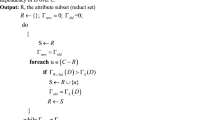Abstract
Case-Based Reasoning systems usually retrieve cases using a similarity function based on K-NN or some derivatives. These functions are sensitive to irrelevant or noisy features. Weighting methods are used to extract the most important information present in the knowledge and determine the importance of each feature. However, this knowledge, can also be incorrect, redundant and inconsistent. In order to solve this problem there exist a great number of case reduction techniques in the literature. This paper analyses and justifies the relationship between weighting and case reduction methods, and also analyses their behaviour using different similarity metrics. We have focused this relation on Rough Sets approaches. Several experiments, using different domains from the UCI and our own repository, show that this integration maintain and even improve the performance over a simple CBR system and over case reduction techniques. However, the combined approach produces CBR system decrease if the weighting method declines its performance.
Preview
Unable to display preview. Download preview PDF.
Similar content being viewed by others
References
Aamodt, A. and Plaza, E. (1994). Case-Based Reasoning: Foundations Issues, Methodological Variations, and System Approaches. In AI Communications, volume 7, pages 39-59.
Aha, D. (1992). Tolerating noisy, irrelevant and novel attributes in instance-based learning algorithms. International Journal of Man-Machine Studies, (36):267–287.
Blum, A. and Langley, P. (1997). Selection of Relevant features and Examples in Machine Learning. In Artificial Intelligence, volume 97, pages 245–271.
Craw, S. and Jarmulak, J. (2001). Maintaining Retrieval knowledge in a case-based reasoning system. Computational Intelligence, 17(2):346–363.
Fayyad, U. and Irani, K. (1993). Multi-interval discretization of continuous-valued attributes for classification learning. In 19th International Joint Conference on Artificial Intelligence, pages 1022–1027.
Golobardes, E., Llorà, X., Salamó, M., and Martí, J. (2002). Computer Aided Diagnosis with Case-Based Reasoning and Genetic Algorithms. Knowledge-Based Systems, (15):45–52.
Hall, M. (2000). Correlation-based feature selection of discrete and numeric class machine learning. In Proc. International Conference on Machine Learning, pages 359–366. Morgan Kaufmann.
Kira, K. and Rendell, L. (1992). A practical approach to feature selection. In Proceedings of the 9th International Conference on Machine Learning, pages 249–256.
Kononenko, I. (1994). Estimating attributes: Analysis and extensions of RELIEF. In Proceedings of the Seventh European Conference on Machine Learning, pages 171–182.
Leake, D. and Wilson, D. (2000). Remembering Why to Remember: Performance-Guided Case-Base Maintenance. In Proceedings of the Fifth European Workshop on Case-Based Reasoning, pages 161–172.
McSherry, D. (2002). Diversity-Conscious Retrieval. In Proceedings of the 6th. European Conference on Case-Based Reasoning, pages 219–233.
Merz, C. J. and Murphy, P. M. (1998). UCI Repository for Machine Learning Data-Bases [http://www.ics.uci.edu/?mlearn/MLRepository.html]. Irvine, CA: University of California, Department of Information and Computer Science.
Pawlak, Z. (1982). Rough Sets. In International Journal of Information and Computer Science, volume 11.
Pawlak, Z. (1991). Rough Sets: Theoretical Aspects of Reasoning about Data. Kluwer Academic Publishers.
Portinale, L., Torasso, P., and Tavano, P. (1999). Speed-up, quality and competence in multi-modal reasoning. In Proceedings of the Third International Conference on Case-Based Reasoning, pages 303–317.
Reinartz, T. and Iglezakis, I. (2001). Review and Restore for Case-Base Maintenance. Computational Intelligence, 17(2):214–234.
Salamó, M. and Golobardes, E. (2002). Analysing rough sets weighting methods for case-based reasoning systems. Inteligencia Artificial. Revista Iberoamericana de Inteligencia Artificial, (15):34–43.
Salamó, M. and Golobardes, E. (2003). Hybrid deletion policies for case base maintenance. In FLAIRS-2003, page To appear.
Smyth, B. and Keane, M. (1995). Remembering to forget: A competence-preserving case deletion policy for case-based reasoning systems. In Proceedings of the Thirteen International Joint Conference on Artificial Intelligence, pages 377–382.
Smyth, B. and McClave, P. (2001). Similarity vs. Diversity. In Proceedings of the 4th. International Conference on Case-Based Reasoning, pages 347–361.
Smyth, B. and McKenna, E. (2001). Competence Models and the maintenance problem. Computational Intelligence, 17(2):235–249.
Wilson, D. and Martinez, T. (2000a). An integrated instance-based learning algorithm. Computational Intelligence, 16(1):1–28.
Wilson, D. and Martinez, T. (2000b). Reduction techniques for Instance-Based Learning Algorithms. Machine Learning, 38, pages 257–286.
Author information
Authors and Affiliations
Editor information
Editors and Affiliations
Rights and permissions
Copyright information
© 2003 Springer-Verlag Berlin Heidelberg
About this paper
Cite this paper
Salamó, M., Golobardes, E. (2003). Unifying Weighting and Case Reduction Methods Based on Rough Sets to Improve Retrieval. In: Ashley, K.D., Bridge, D.G. (eds) Case-Based Reasoning Research and Development. ICCBR 2003. Lecture Notes in Computer Science(), vol 2689. Springer, Berlin, Heidelberg. https://doi.org/10.1007/3-540-45006-8_38
Download citation
DOI: https://doi.org/10.1007/3-540-45006-8_38
Published:
Publisher Name: Springer, Berlin, Heidelberg
Print ISBN: 978-3-540-40433-0
Online ISBN: 978-3-540-45006-1
eBook Packages: Springer Book Archive




